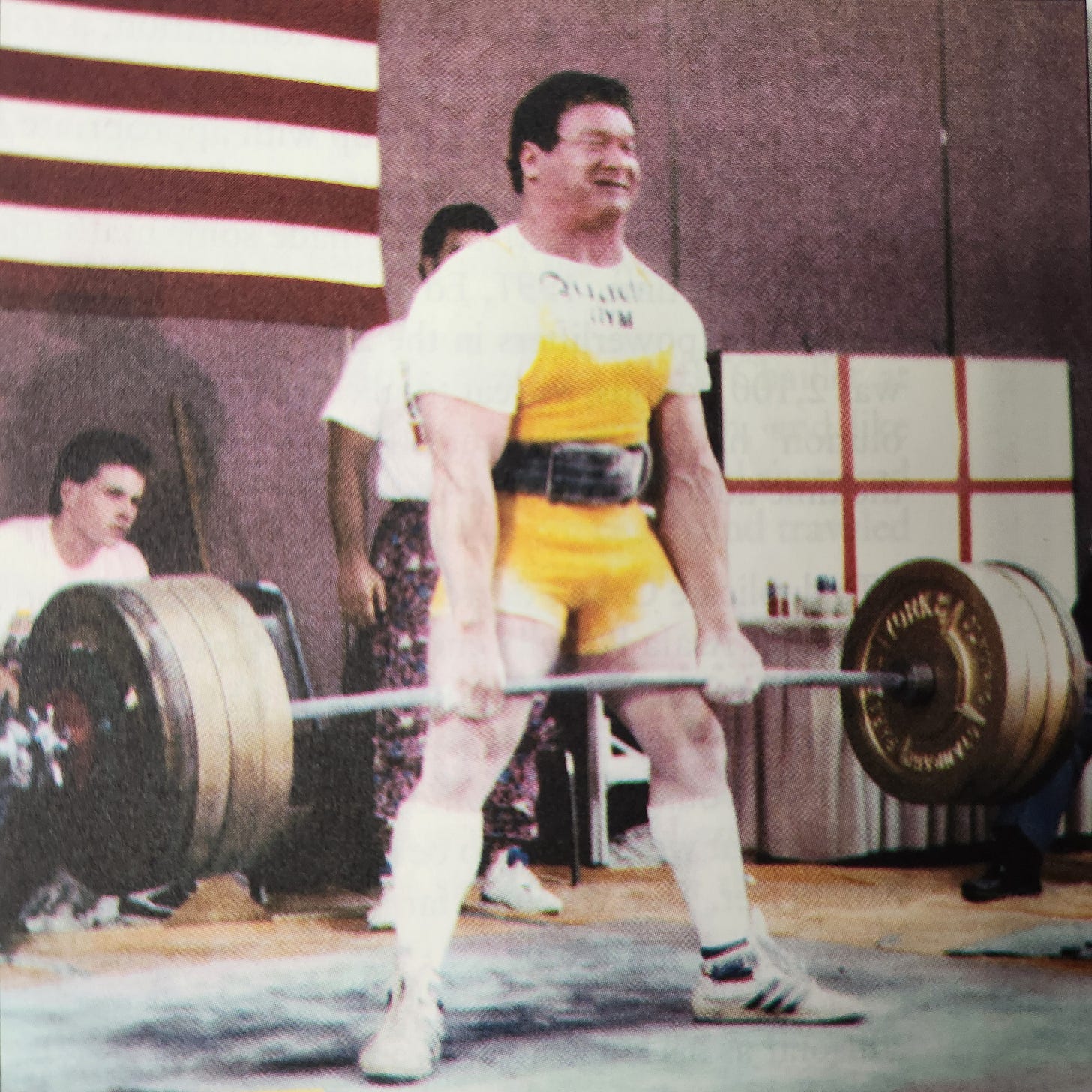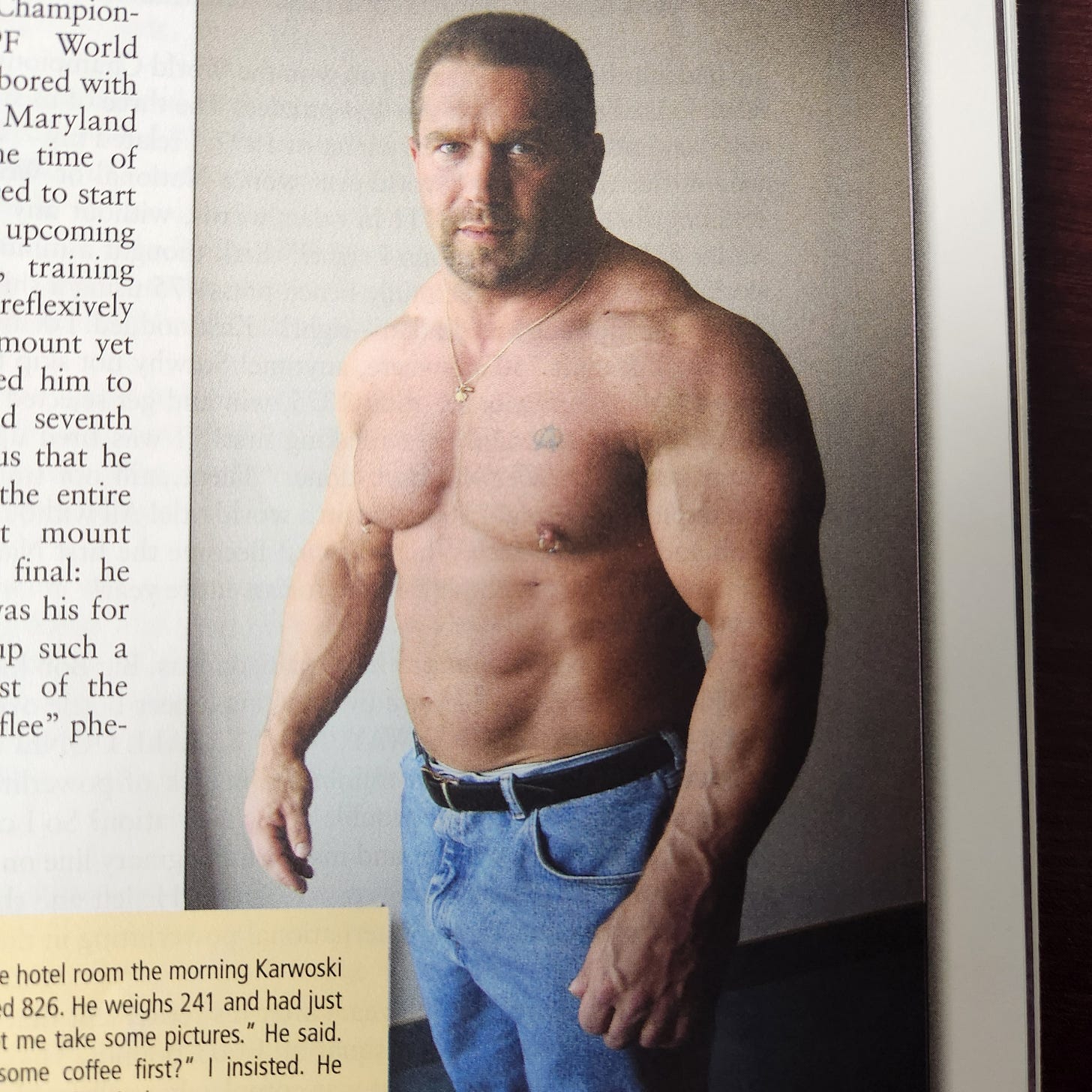“If you can manage to not f@#$ up for 20 seconds, you’re gonna’ make that lift.” -Kirk Karwoski

If your goal is to get strong and build the necessary muscle mass to maintain those strength gains, a classic power training split is hard to beat.
The classic power training split usually devotes one training day to one of the specific power lifts with assistance exercises chosen to build the muscles that support the lift. This is the type of training that built the legendary strength and physiques of powerlifters such as Kirk Karwoski and Ed Coan.
This type of training was essentially “power-bodybuilding” as it bridged the gap between powerlifting and bodybuilding training. The physique that resulted was the classic “power physique”. Huge traps, wide shoulders, a thick back, and powerful legs. While these lifters weren’t always sporting a 6-pack, they possessed exceptional muscular development and were every bit as strong as they looked.
The training split is typically spread over four days and while some lifters added a fifth day, usually for direct shoulder exercises, it could be trimmed down to three days quite easily as well.
The 4-Day Split
This is a very common power training split where one day is devoted to each the squat, bench press and deadlift. An additional fourth day is added for either bench accessory or arm and shoulder training. A good example of this would be Kirk Karwoski’s training plan, as outlined in the book The Purposeful Primitive, authored by Kirk’s coach Marty Gallagher.
Monday (Legs): squat, leg curl, leg extension
Tuesday (Chest, Arms): close grip bench press, biceps curls, triceps pushdowns
Thursday (Back): deadlift, grip shrugs, T-bar rows, pulldowns, dumbbell shrugs
Saturday (Chest): competition grip bench press, paused wide-grip bench press, incline bench press, front shoulder raise, lateral shoulder raise
The primary lifts, squat, close grip bench, deadlift, and bench press were progressed in a linear fashion over a 12-week cycle progressing from a top set of 8 reps, to 5 rep, 3 rep, and 2 rep sets. The accessory exercises were performed with heavy weights in the 5-8 rep range. This is the training that led to Karwoski winning 6 IPF World Championship titles and built one of the most impressive physiques in powerlifting history.

The 5-Day Split
Some lifters who prefer to train with a higher frequency and higher volume of accessory exercises might opt for the 5-day training split favored by the greatest powerlifter of all-time, Ed Coan. Coan’s plan dedicates one day to the squat, bench press, deadlift, and bench assistance, while adding a fifth day dedicated strictly to shoulder exercises. An example of Ed’s plan is as follows.
Monday (Legs): squat, single-leg leg press, leg curl, leg extension, calf raise, abs
Wednesday (Chest): bench press, close grip bench press, incline bench press, triceps extension, abs
Thursday (Shoulders): behind the neck barbell press, front dumbbell raise, lateral dumbbell raise
Friday (Back): deadlift, stiff leg deadlift, bent over barbell row, T-bar row, chin-ups, pulldowns, rear delt raise, calf raise, abs
Saturday (Light Bench & Arms): wide grip bench, dumbbell flies, weighted dips, triceps extensions, biceps curls
Ed followed a similar linear progression of his main lifts as Karwoski, progressing from top work sets of 10, 8, 5, 3, and 2 reps. Ed’s primary assistance exercises such as the close grips, inclines, behind the neck press, stiff leg deadlifts, and barbell rows were progressed in the same set and rep manner as his main lifts, which is a fascinating detail and something most lifters didn’t do, opting instead for sets of moderately heavy weights performed in the 5-8 range. The smaller accessory exercises such as triceps extensions, calf raises, curls, and abs were usually done for 2-3 sets of higher reps. This, coupled with smart planning and excellent attention to detail not only netted Ed countless National and World titles and records, but the title of greatest of all-time.
The 3-Day Split
This training split was the most common 3-day plan I came across in the early to mid-90s when I first became interested in power training. While this split has many benefits, I rarely see competitive lifters following such a plan. The vast majority tend toward the 4-day split. For those who may need a greater focus on recovery, this plan would likely work well. Case in point, one of my jiu-jitsu training partners, who is built more like a powerlifter than a marathon runner, was asking my opinion on training that emphasized recovery. This was the exact plan I recommended to him.
Monday (Legs): squat, single leg squat, leg curls, calves, abs
Wednesday (Chest): bench press, incline bench press, close grip bench press, triceps extensions, front shoulder raise, lateral shoulder raise, abs
Friday (Back): deadlift, stiff leg deadlift, bent over barbell row, chin-ups, shrugs, biceps curls, abs
For the squat, bench press, and deadlift you could follow a similar linear progression as laid out in the 4- and 5-day splits. Weeks 1 and 2 work up to a heavy 10 rep set, weeks 3 and 4 work up to a heavy 8 rep set, weeks 5-8 work up to heavy 5 rep sets, weeks 9 and 10 work up to heavy triples, and weeks 11 and 12 work up to heavy doubles. Accessory exercises should focus on increasing weights for 5-10 reps.
Training does not have to be complicated or complex to be effective. Simple training plans like those laid out here have, and will continue to produce, exceptional results in building strength and muscle mass.
I hope you enjoyed this week’s article, and until next time, stay strong and healthy!




Scott, with these articles you are giving me too much food for thought mate 😂. This article is making me scratch my head now, especially the 3 day split. Either this one or Westside method . What do you think?